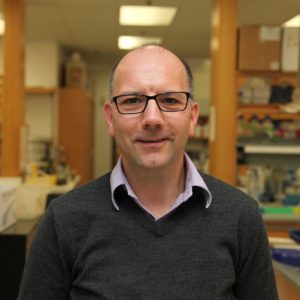Pioneering research from Vanderbilt scientists shows that cells respond differently to acute stress than to gradual stress. The findings establish an entirely new way to look at cell-to-cell communication, or signaling, and may fundamentally change how biomedical researchers study cells.


Research led by Alexander Thiemicke, former graduate student in chemical and physical biology, and Gregor Neuert, assistant professor of molecular physiology and biophysics, was published in the journal Science Advances on Feb. 19. Their study sought to clarify how cells behave in environments where stress is changed gradually, as opposed to conditions that produce rapid change.
“Looking at how cells respond to perturbations in their environments in this way is an entirely new approach in biomedical research,” said Neuert, also a Dean’s Faculty Fellow and a NIH New Innovator Awardee. “This has serious implications as we unravel fundamental biological questions and for how drug development is pursued.”
Testing drugs on cells in a conventional laboratory setting often produces acute changes within the cells, creating conditions that are nothing like what happens when the drug actually interacts with the human body. These rapid changes can produce unanticipated results and ultimately derail the clinical trial.
Developing an environment that more closely matches the gradual conditions found in nature has the potential to move research from bench to bedside more quickly. It also gives researchers better data that can be used to strengthen drug-screening techniques.
With a background in physics and engineering, Neuert has long been interested in better understanding how cells respond to stress. “In a traditional biology education, trainees often look only at quick changes in cell environments,” he said. “Developing a systematic and quantitative approach to this research was unique to biology and enabled these experiments.”
By comparing how cells respond to acute changes versus those that happen gradually over time—like insulin cycles, hormonal changes during pregnancy, oxygen reduction, or exposure to ultraviolet light—researchers now have a more physiologically relevant context to inform their developing therapies.
The study was conducted by changing—first gradually and then suddenly—the amount of salt surrounding immune cells that typically exist in the kidney and intestine. This alteration causes osmosis, the movement of water across the cell membrane.
In their research, Neuert and Thiemicke looked for changes to 25 markers of cell stress and cell death, including caspases—a family of proteins that are precursors to cell death. They determined that with gradual stress, 60 percent of cells die, whereas if cells are exposed to the same change acutely, 90 percent of them die.
Amid gradual changes, cells increase their uptake of protective amino acids to defend themselves against the extracellular stress. Upon acute stress, however, a cell death program is triggered that forces controlled death without enough time for the cell to protect itself. Further, the researchers found that, if cells are acutely stressed but are given those protective amino acids, they survive at rates similar to the cells that were under gradual stress.
The work is built on years of research in the field. In a January 2021 study published in the journal Proceedings of the National Academy of Sciences, postdoctoral fellow Amanda Johnson and colleagues discovered the biological mechanism that determines how yeast cells respond to gradual stress. In an October 2020 study published in the journal iScience, postdoctoral fellow Hossein Jashnsaz and colleagues looked into how the behaviors of networks of proteins that respond to stress can be better theoretically described. This work was done in collaboration with the Munsky Group lab at Colorado State University.
Neuert will continue to study stress signaling within cells. With his findings of the behavioral differences of caspases in acute and gradual environments, he intends to look further into their differential regulation and mechanics.
The research was funded by the NIH Director’s New Innovator DP2 award (GM11484901), a R01 from the National Institute of General Medical Sciences (5R01GM115892), the American Heart Association Pre-doctoral Fellowship award (18PRE34050016), the Ion Channels and Transporters Training Grant (T32NS0074), the Molecular Biophysics Training Grant (5T32GM008320), the Advanced Computing Center for Research and Education (1S10OD023680-01), Vanderbilt Institute for Clinical and Translational Research (VR53716) and Vanderbilt Startup Funds.